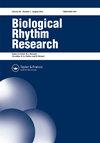光照对中华绒螯蟹肠道菌群的影响
IF 0.9
4区 生物学
Q3 BIOLOGY
引用次数: 0
摘要
光周期是影响甲壳类动物生理活动和摄食行为的重要环境因子。本研究旨在探讨光周期对中华绒螯蟹肠道细菌群落组成的影响机制。本研究采用高通量16S rRNA测序技术,鉴定了三种不同光照下中华梭菌肠道细菌的变异:在24 L:0 D、0 L:24 D和12 L:12 D条件下,完全光照组和完全黑暗组的群落丰富度和多样性Shannon和Chao1指数在第4天时差异显著,但在第6天时差异消失,说明肠道细菌群落在第4天时被破坏,但在第6天时适应了新的环境。在所有条件下,微内门和变形菌门均为优势门。在完全光照和完全黑暗条件下,梭状芽孢杆菌的丰度在第6天显著增加。这些数据表明,在不同光照条件下,中华梭菌的生物钟使肠道细菌群落组成的变化最小化。考虑到肠道细菌群落对寄主有着深远的影响,了解其影响的各种机制(包括与光周期的相互作用)应该有助于改善中华鄂蚌养殖。本文章由计算机程序翻译,如有差异,请以英文原文为准。
Impacts of light on gut microbiota in Chinese mitten crab (Eriocheir sinensis)
ABSTRACT Photoperiod is an essential environmental factor that affects physiological activity and feeding behavior in crustaceans. The current study aimed to investigate the mechanism by which photoperiod influences gut bacterial community composition in the Chinese mitten crab (Eriocheir sinensis). In this study, high-throughput 16S rRNA sequencing was used to identify variations in E. sinensis gut bacteria under three different light: dark conditions (24 L:0 D, 0 L:24 D, and 12 L:12 D). Shannon and Chao1 indexes of community richness and diversity differed significantly between the complete light group and complete dark group on day 4, but these differences disappeared by day 6, suggesting that the gut bacterial community became disrupted on day 4, but adjusted to the new environment by day 6. Tenericutes and Proteobacteria were the dominant phyla under all conditions. Clostridium abundance increased significantly on day 6 under conditions of complete light and complete darkness. These data suggest that the biological clock of E. sinensis minimized changes in gut bacterial community composition under different light conditions. Considering that the gut bacterial community has profound effects on the host, understanding various mechanisms of its influence (including interactions with photoperiod) should be useful for improving E. sinensis aquaculture.
求助全文
通过发布文献求助,成功后即可免费获取论文全文。
去求助
来源期刊

Biological Rhythm Research
生物-生理学
CiteScore
3.00
自引率
9.10%
发文量
34
审稿时长
6-12 weeks
期刊介绍:
The principal aim of Biological Rhythm Research is to cover any aspect of research into the broad topic of biological rhythms. The area covered can range from studies at the genetic or molecular level to those of behavioural or clinical topics. It can also include ultradian, circadian, infradian or annual rhythms. In this way, the Editorial Board tries to stimulate interdisciplinary rhythm research. Such an aim reflects not only the similarity of the methods used in different fields of chronobiology, but also the fact that many influences that exert controlling or masking effects are common. Amongst the controlling factors, attention is paid to the effects of climate change on living organisms. So, papers dealing with biometeorological aspects can also be submitted.
The Journal publishes original scientific research papers, review papers, short notes on research in progress, book reviews and summaries of activities, symposia and congresses of national and international organizations dealing with rhythmic phenomena.
 求助内容:
求助内容: 应助结果提醒方式:
应助结果提醒方式:


